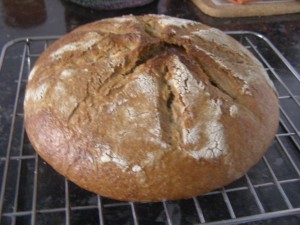For the impatient, the long story is put short in a picture, so lo and behold, the Ugly Breadling itself, fresh from the oven, but still not quite that young 1. Do admire the crater-like overall aspect and after you marvel, read ahead for the story is just about to begin…
I can certainly blame the idea of breadmaking on my whole background and ancestry. My people have supposedly made and ate bread through several centuries already, quite with the same fervour with which Turks make halva and Italians pasta. I quite suspect there was a bit more fervour in the eating than in the making, not to mention that it was more likely that only half of the people did the making while the rest did the eating, but that is neither here nor there, but already burnt in the ovens of the past.
Compared with such complicated and illustrious ancestry, the Ugly Breadling is certainly nothing but a puny, modern-day imitation of the fabulous breads of the past. Nevertheless, its scorched and ugly crust delivers the most satisfying crunch as well as access to a long-forgotten taste. A taste perhaps more uneven, stronger, more flavoursome, slightly sour in the beginning, but getting better as the bread cools down, getting even better as the bread ages a bit, a few hours, a few days, a few…. A taste not unlike that of real life, the life that is not pretty, nor easily pierced to its essence, nor easily achieved and nevertheless much stronger for all that, by far preferable to anything else, by far the only one to get better, to get more meaningful with age.
A taste which renders all the others quite unbearable really, quite offensive.
- Despite its dubious aspect, the Ugly Breadling took quite some time to materialize on that tabletop. And by “quite some time” I mean close to 24 hours. Throw in a lot of steam and a really hot oven, plus strange kneading (the technical term is Stretch-and-fold) in the night, covered pots in the fridge and a hasty transfer to a hot and heavy stone. Still, in all this lengthy process, there is surprisingly little work: it takes more patience, diligence and either intimate knowledge of the ingredients and of the dough or a very careful following of the rules.[↩]
Comments feed: RSS 2.0
